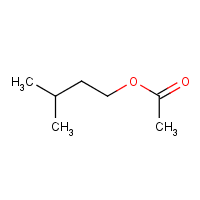Isoamyl acetate
Agent Name
Isoamyl acetate
Alternative Name
Isopentyl acetate
CAS Number
123-92-2
Formula
C7-H14-O2
Major Category
Solvents

Synonyms
Isopentyl acetate; 1-Butanol, 3-methyl-, acetate; 2-Methylbutyl ethanoate; 3-Methyl-1-butanol acetate; 3-Methyl-1-butyl acetate; 3-Methylbutyl acetate; 3-Methylbutyl ethanoate; Acetic acid, 3-methylbutyl ester; Acetic acid, isopentyl ester; Amyl acetate, common; Amylacetic ester; Banana oil; I-Amyl acetate; Isoamyl acetate; Isoamyl acetate (natural); Isoamyl ethanoate; Isoamylester kyseliny octove [Czech]; Isopentyl acetate; Isopentyl alcohol, acetate; Isopentyl ethanoate; Pear oil; beta-Methylbutyl acetate; [ChemIDplus] UN1993
Category
Esters (<C12)
Description
Colorless liquid with a banana-like odor; [NIOSH]
Sources/Uses
Used as an additive to aerosols and cosmetics and to fit-test respirators; [ACGIH]
Comments
Esters may induce narcosis in animal experiments, but workers' exposures are limited by irritating effects. See appendix in: [Dick RB, et al. Chemicals in the workplace: incorporating human neurobehavioral testing into the regulatory process. Am J Ind Med. 1998 May;33(5):439-53.] A skin, eye, and respiratory tract irritant; Inhalation of high concentrations can cause CNS depression; [ICSC] The pentyl acetates are sensory irritants in the work environment. At higher levels in animal experiments, they cause narcosis, hepatotoxicity, and developmental toxicity. [ACGIH]
Biomedical References
Exposure Assessment
Skin Designation (ACGIH)
Insufficient data
TLV (ACGIH)
50 ppm
STEL (ACGIH)
100 ppm
PEL (OSHA)
100 ppm
MAK
50 ppm
IDLH (NIOSH)
1000 ppm
Excerpts from Documentation for IDLHs
"Isoamyl acetate is considered more irritating than butyl acetate. Exposure to 1,000 ppm for 30 minutes resulted in irritation, dyspnea, fatigue, and increased pulse [Amor 1950]. It is considered dangerous to life after 5 hours of exposure to 10,000 ppm [Browning 1965]." [NIOSH]
Vapor Pressure
5.6 mm Hg
Odor Threshold Low
0.0034 ppm
Odor Threshold High
209 ppm
Explanatory Notes
Detection odor threshold from AIHA (mean = 0.22 ppm); Flash point = 77 deg F; VP from HSDB;
Half Life
No reports found; [TDR, p. 95]
NFPA
may ignite at ambient temp
Adverse Effects
Neurotoxin
Acute solvent syndrome
Hepatotoxin
Hepatoxic (a) from occupational exposure (secondary effect) or (b) in animal studies or in humans after ingestion
Diseases, Processes, and Activities Linked to This Agent
Diseases
Occupational diseases associated with exposure to this agent: